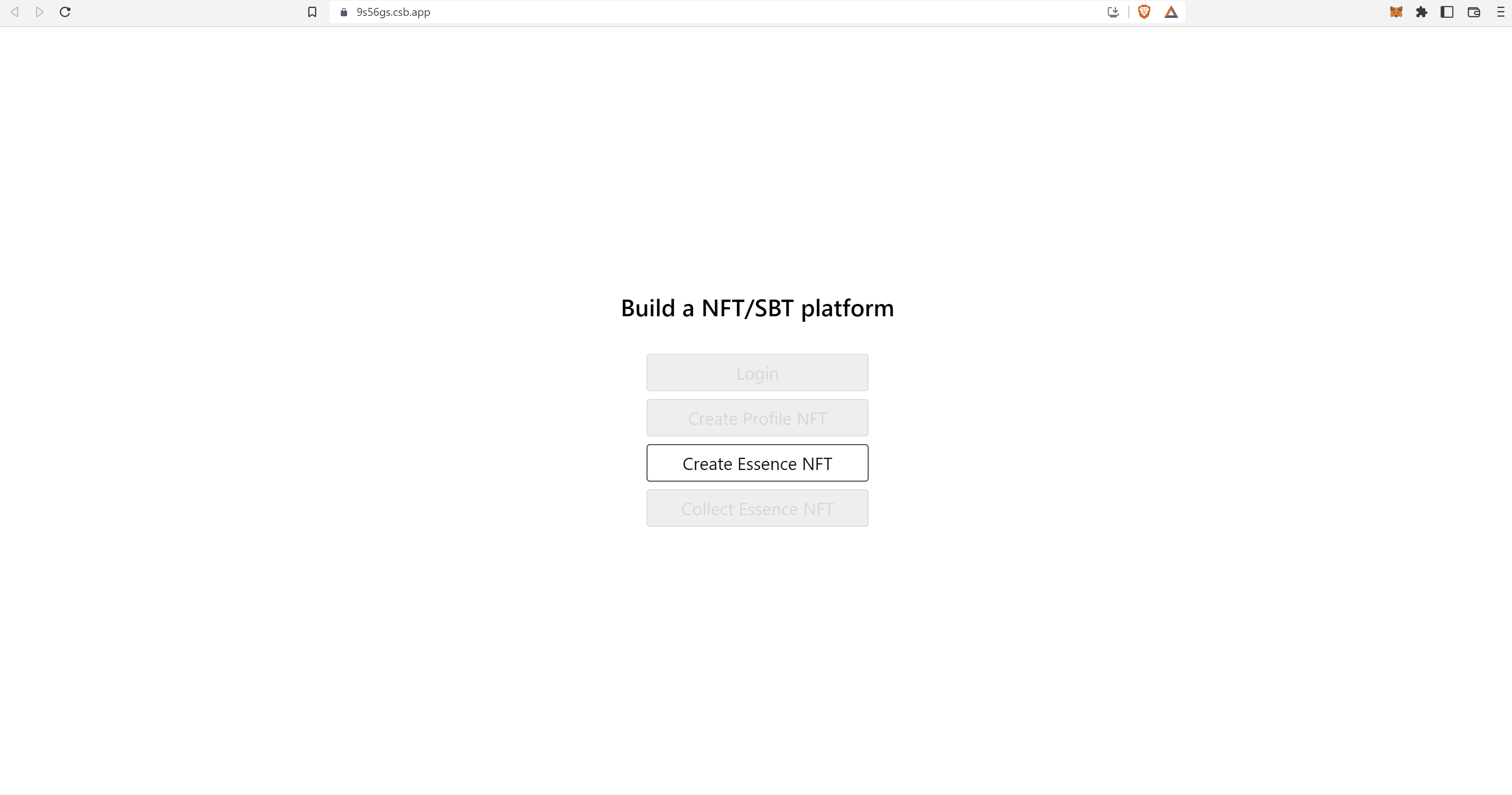Create Essence NFT
In order to Create an Essence NFT, you will actually be implementing the steps described in the Register Essence section.
Workflow

GraphQL mutations
As previously mentioned, you will Register an Essence. To do so, you need to write the GraphQL mutations required for it:
- first mutation is to format data so that the user can sign data in a readable format:
import { gql } from "@apollo/client";
export const CREATE_REGISTER_ESSENCE_TYPED_DATA = gql`
mutation CreateRegisterEssenceTypedData(
$input: CreateRegisterEssenceTypedDataInput!
) {
createRegisterEssenceTypedData(input: $input) {
typedData {
id
chainID
sender
data
nonce
}
}
}
`;
- second mutation is to call the
relaythat will broadcast the transaction and create the Essence NFT:
import { gql } from "@apollo/client";
export const RELAY = gql`
mutation Relay($input: RelayInput!) {
relay(input: $input) {
relayTransaction {
id
txHash
typedData {
id
chainID
sender
data
nonce
}
}
}
}
`;
Metadata schema
info
The underlying difference between a Non-fungible token (NFT) and a Soulbound token (SBT) is that the SBT is a non-transferable token.
The metadata schema contains all the fields that make up the minted NFT/SBT. In other words, it holds data used to display the Essence NFT in your app and it is customized by the user based on the user's input.
The schema can be slipt into 3 main parts:
The first part follows the Opensea Metadata Standard.
The second part we entitled it CyberConnect Metadata Schema and this is common for all Essence NFTs.
The third part consists of a couple of fields that are specific to SBTs.
In this example you will creating a SBT which means that the metadata will contain the required fields specific to SBTs:
holderis the user's handle;issueris the address that created it;
A couple of things to note, like setting the correct type as SBT for it (useful for indexing) and pass the transferable param as false since, as previously mentioned, SBTs are non-transferable tokens.
const metadata = {
// Opensea standard schema
image: "https://gateway.pinata.cloud/ipfs/QmNcqSpCvhiyHocUaVf7qB8qwEGerSpnELeAi567YEraYm", // string (required, only optional if `animation_url` has value)
image_data: "",
description: `SBT of @${handle}`, // string (optional)
name: `@${handle} SBT`, // string (required)
attributes: [], // array (required)
animation_url: "", // string (required, only optional if `image` has value)
external_url: "", // string (optional)
background_color: "", // string (optional)
youtube_url: "", // string (optional)
// CyberConnect schema
media: [], // (required, empty array for SBT)
version: "1.0.0", // string (required)
appId: DEMO_APP_ID, // string (required)
locale: "en", // string (optional)
type: "SBT", // "PUBLICATIONS" | "SBT" (optional, default is `PUBLICATIONS`)
issued_date: new Date(), // string (required)
// Specific to SBT
holder: `@${handle}`, // string (required)
issuer: address, // string (required)
venue: "", // string (optional) e.g. Discord, Twitter etc.
};
Create Essence NFT
Now that we've covered the Metadata schema, what is left to do is to put all logic into a CreateEssenceNFTBtn component. Once the button is clicked, it will compute the tokenURI as a base64 string and call both createRegisterEssenceTypedData and relay APIs.
import { Web3Provider } from "@ethersproject/providers";
import { useMutation } from "@apollo/client";
import { CREATE_REGISTER_ESSENCE_TYPED_DATA, RELAY } from "../graphql";
const DEMO_CHAIN_ID = 5; // Goerli Test Network
const DEMO_NAMESPACE = "CyberConnect";
const DEMO_APP_ID = "CyberConnect";
const DEMO_OPERATOR_MW_CONTRACT = "0x0000000000000000000000000000000000000000";
function CreateEssenceNFTBtn({
provider,
handle,
profileID,
setEssenceID,
disabled,
}: {
provider: Web3Provider | null,
handle: string,
profileID: number,
setEssenceID: (essenceID: number) => void,
disabled: boolean,
}) {
const [createRegisterEssenceTypedData] = useMutation(
CREATE_REGISTER_ESSENCE_TYPED_DATA
);
const [relay] = useMutation(RELAY);
const handleOnClick = async () => {
try {
// Check for the provider
if (!provider) {
throw Error("No provier detected.");
}
// Check for the chain id
const network = await provider.getNetwork();
const chainID = network.chainId;
if (chainID !== DEMO_CHAIN_ID) {
throw Error("Wrong chain.");
}
// Construct metadata for SBT
const signer = provider.getSigner();
const address = await signer.getAddress();
const metadata = {
// Opensea standard schema
image: "https://gateway.pinata.cloud/ipfs/QmNcqSpCvhiyHocUaVf7qB8qwEGerSpnELeAi567YEraYm", // string (required, only optional if `animation_url` has value)
image_data: "",
description: `SBT of @${handle}`, // string (optional)
name: `@${handle} SBT`, // string (required)
attributes: [], // array (required)
animation_url: "", // string (required, only optional if `image` has value)
external_url: "", // string (optional)
background_color: "", // string (optional)
youtube_url: "", // string (optional)
// CyberConnect schema
media: [], // (required, empty array for SBT)
version: "1.0.0", // string (required)
appId: DEMO_APP_ID, // string (required)
locale: "en", // string (optional)
type: "SBT", // "PUBLICATIONS" | "SBT" (optional, default is `PUBLICATIONS`)
issued_date: new Date(), // string (required)
// Specific to SBT
holder: `@${handle}`, // string (required)
issuer: address, // string (required)
venue: "", // string (optional) e.g. Discord, Twitter etc.
};
// Construct tokenURI as string
const tokenURI = `data:application/json;base64,${Buffer.from(
JSON.stringify(metadata),
"binary"
).toString("base64")}`;
// Collect input
const name = prompt("SBT name:") || "Demo SBT";
const symbol = prompt("SBT symbol:") || "SBT";
// Create typed data
const typedDataResult = await createRegisterEssenceTypedData({
variables: {
input: {
options: {
namespaceName: DEMO_NAMESPACE,
chainID: chainID,
},
profileID: profileID,
name: name,
symbol: symbol,
tokenURI: tokenURI,
mwContract: DEMO_OPERATOR_MW_CONTRACT,
transferable: false, // SBTs are non-transferable
},
},
});
const typedData =
typedDataResult.data?.createRegisterEssenceTypedData?.typedData;
const message = typedData.data;
const typedDataID = typedData.id;
// Get signature for typed data
const fromAddress = address;
const params = [fromAddress, message];
const method = "eth_signTypedData_v4";
const signature = await signer.provider.send(method, params);
// Relay
const relayResult = await relay({
variables: {
input: {
typedDataID: typedDataID,
signature: signature,
},
},
});
const txHash = relayResult.data?.relay?.relayTransaction?.txHash;
console.log("~~ Tx hash ~~");
console.log(txHash);
// Update state for essenceID
// First Essence NFT created will start at 1. Second Essence NFT will have the essenceID 2, etc.
setEssenceID(1);
alert(`Successfully created the SBT!`);
} catch (error) {
alert(error);
console.error(error);
}
};
return (
<button onClick={handleOnClick} disabled={disabled}>
Create Essence NFT
</button>
);
}
export default CreateEssenceNFTBtn;
The relay will return as a reponse the txHash that you can verify on goerli.etherscan.io to check that the SBT was indeed created!
Well done! Next up, you will learn how to implement the Collect an Essence NFT functionality.